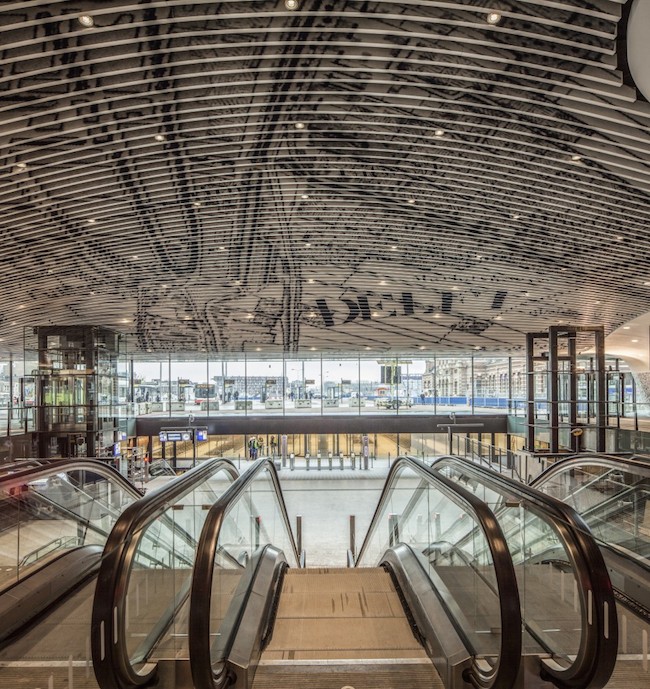Mecanoo is an international studio that was founded in 1984 in the historic city of Delft, Netherlands. Their architectural designs seek to blend technical expertise within a context of cultural settings, place and time.

They have worked with architects Benthem Crouwel on Delft’s train station and city hall building , for the last six years. ArchDaily announced this week that the first phase, which features Mecanoo’s ceiling-mounted 1877 map of the city across sixty vertical aluminum ribs and columns covered in abstract fragments of Delft blue tiles, is open to the public. The full project is scheduled to be completed by 2017.


It’s designed to create a “unforgettable arrival experience” when people enter and it does. Francine Houben, Mecanoo’s creatives directive director:
“…coming up the escalators, the impressive ceiling with the historic map of Delft unfolds. When you look outside, you see the city and the old station as a modern View of Delft by the painter Johannes Vermeer.”

The architects further state that:
The character of Delft and the combination of past and future was the starting point in the development of the design. This town of historic buildings and canals, once known as the ‘Prinsenstad’ and deeply connected to the Dutch Royal Family, is now at the forefront of technical development. The Technical University of Delft, which has one Europe’s top architecture schools, is a world-leader in engineering innovation.



The city hall above the station, still under construction, has a glazed skin designed to “reflect the Dutch skies.” Panels of fused glass with lens-like spheres refer to the molten glass vernacular that can be found in many of Delft’s historic buildings. The combination and rhythm of open panels of high performance glass and closed fused glass panels contribute to an energy-efficient climate concept. Incisions in the glass volume of the municipal offices form a pattern of alleyways and courtyards, inspired by the intricate structure of this city for which this station is the heart.

The new station’s footprint superimposed on old Delft.
Benthem Crouwel notes the way the station catches and plays with light and shines:
“A mezzanine floor in the tall space of the station hall, the central access and the glass floor in front of the entrance bring daylight down to the platform level. Furthermore the gleaming aluminum ceiling and light granite floor ensure optimum reflection of light. Waiting and information areas on the platform are marked with additional lighting. The sturdy ceiling of fins unfolds as a pergola which offers travelers protection while preserving the mysterious sense of space in the big hall.”

Mecanoo’s palette guide.
Delft received its city charter in 1246 and in 1581 became the de facto capital of the newly independent Netherlands and the seat of the Prince of Orange. Today this busy tourist destination is known internationally for two cultural glories, it was the birthplace and home of the painter Johannes Vermeer (1632-1675) and is one the most famous pottery towns in the world.
Defltware, its pottery, is collected and imitated worldwide. This distinctive blue and white tin-glazed earthenware pottery actually was first made in Antwerp by the Italian Potter Guido da Savino who settled there in 1500. Delft became the center for this ware designed to mimic blue and white Chinese porcelain. These porcelains were imported by the Dutch East India Company and cost a fortune, accessible only to the rich. Being less costly Delftware could sell to a broader market.

Five Part garniture, tin-glazed earthenware, c. 1690 De Metaale Pot Factory, Delft. Courtesy of the Metropolitan Museum of Art, New York. Click to enlarge.
Delft’s prominence in this pottery was the side effect of a massive gunpowder explosion in the town 1654 that laid waste many breweries and put that industry into decline. Their premises became available to pottery makers looking for larger potteries and some Defltware makers even some retained the old brewery names, The Double Tankard, The Young Moors’ Head, and The Three Bells.
Eventually the artistry of the Dutch potters and decorators became so impressive that they became highly valued in their own right selling to collectors throughout Europe and even being exported to Japan and China. After a golden period from 1640-1750 the importance and aesthetic quality of the work began to decline but it remained a populist product (much of paradoxically now made in China) and an iconic indelible emblem of Dutch culture and this City’s legacy.

Mecanoo’s station is a truly brilliant combination of vibrant contemporary architecture linked to the city’s historic legacy without short changing either.
Garth Clark is Executive Editor of CFile.
Any thoughts about this post? Share yours in the comment box below.

A video tour of the station.



progetto bellissimo ed emozionante. Devo assolutamente visitarlo. Grazie M.
An engineering and artistic wonderment!
It is always so gratifying and uplifting to see architecture that is not the product of the accounts department, but illustrates a true reflective vision (is that an oxymoron?) of place and history. It always makes me feel optimistic…nice post. Thanks Garth Clark.